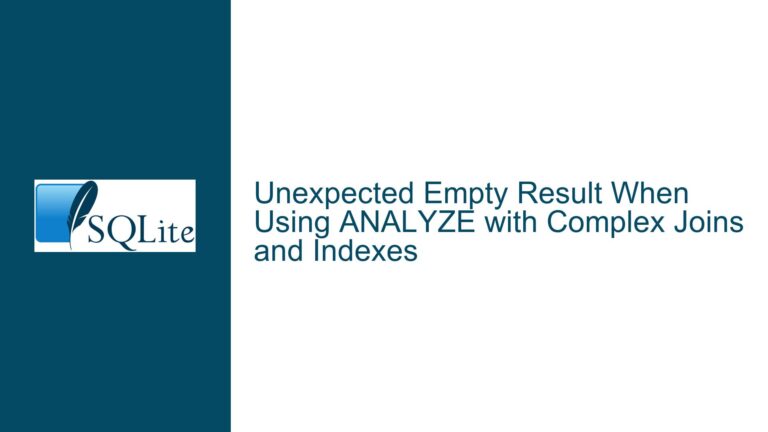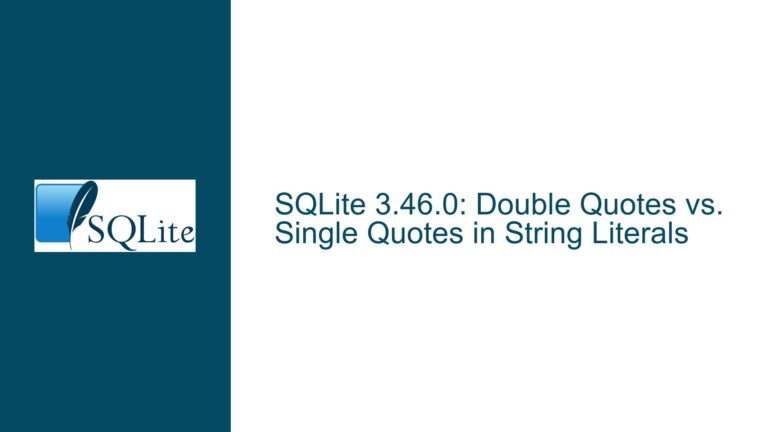Inconsistent SUM Results Due to Floating-Point Precision and Query Structure
Floating-Point Precision and Aggregate Function Behavior in SQLite
Issue Overview
The core issue revolves around the inconsistent results produced by aggregate functions, specifically the SUM function, in SQLite when dealing with floating-point arithmetic and complex query structures. The problem manifests when two seemingly similar queries yield different results due to the inherent limitations of floating-point precision and the order of operations in SQLite’s execution engine.
The first query calculates the sum of a column directly:
SELECT SUM(a15.c1) FROM v0 AS a15 ORDER BY 1; -- Result: -16.0
The second query uses a nested subquery with UNION ALL to calculate the sum under different conditions:
SELECT SUM(aggr) FROM (
SELECT SUM(a15.c1) AS aggr FROM v0 AS a15 WHERE (a15.c2) IS TRUE
UNION ALL
SELECT SUM(a15.c1) AS aggr FROM v0 AS a15 WHERE (a15.c2) IS FALSE
UNION ALL
SELECT SUM(a15.c1) AS aggr FROM v0 AS a15 WHERE (a15.c2) IS NULL
ORDER BY 1
); -- Result: 100.0
The discrepancy arises from the way SQLite handles floating-point arithmetic and the order in which operations are executed. Floating-point numbers in SQLite, like in most computing systems, are subject to rounding errors due to their finite precision. This becomes particularly problematic when dealing with large numbers or when performing arithmetic operations that involve subtraction or addition of numbers with vastly different magnitudes.
Possible Causes
Floating-Point Precision Limitations: SQLite uses 64-bit floating-point numbers (IEEE 754 double-precision) for its
REALdata type. This means that numbers with more than 15-17 significant digits may not be represented accurately. When performing arithmetic operations, especially those involving large numbers, rounding errors can accumulate, leading to unexpected results.Order of Operations: The order in which SQLite executes operations can affect the final result. In the first query, the
SUMfunction is applied directly to the column, and the result is influenced by the order of rows in the table. In the second query, theSUMfunction is applied to subsets of the data (filtered byWHEREclauses), and the results are combined usingUNION ALL. The intermediate results of these subset sums may have different rounding errors, which propagate to the final result.Data Type Coercion: SQLite is dynamically typed, meaning that it may implicitly convert data types during operations. For example, when comparing or performing arithmetic operations on columns with mixed data types (e.g.,
INTEGERandREAL), SQLite may coerce values to a common type, potentially introducing additional rounding errors.Query Structure and Optimization: SQLite’s query optimizer may choose different execution plans for the two queries, leading to different intermediate results. The optimizer’s decisions are influenced by factors such as indexes, table statistics, and the complexity of the query. These differences in execution plans can exacerbate the effects of floating-point precision limitations.
Troubleshooting Steps, Solutions & Fixes
Understand Floating-Point Precision: Before attempting to resolve the issue, it is crucial to understand the limitations of floating-point arithmetic. Review the SQLite documentation on floating-point numbers (https://sqlite.org/floatingpoint.html) to gain a deeper understanding of how SQLite handles these types and the potential for rounding errors.
Avoid Large Floating-Point Numbers: If possible, avoid using extremely large floating-point numbers in your calculations. If your data involves large numbers, consider using the
INTEGERdata type instead, as it does not suffer from the same precision limitations. For example, instead of storing18446744073709551615.0, store it as an integer if the fractional part is not needed.Use Consistent Data Types: Ensure that all columns involved in arithmetic operations have consistent data types. If you need to perform calculations on mixed data types, explicitly cast them to a common type to avoid implicit coercion. For example:
SELECT SUM(CAST(a15.c1 AS REAL)) FROM v0 AS a15;Break Down Complex Queries: If you encounter inconsistent results with complex queries, try breaking them down into simpler components. Execute each subquery independently and inspect the intermediate results. This can help identify where the precision errors are introduced. For example:
-- Execute each subquery separately SELECT SUM(a15.c1) AS aggr FROM v0 AS a15 WHERE (a15.c2) IS TRUE; SELECT SUM(a15.c1) AS aggr FROM v0 AS a15 WHERE (a15.c2) IS FALSE; SELECT SUM(a15.c1) AS aggr FROM v0 AS a15 WHERE (a15.c2) IS NULL;Compare the results of these subqueries to the final result of the combined query to identify discrepancies.
Use Decimal Arithmetic Libraries: If precise decimal arithmetic is required, consider using an external library or extension that provides decimal arithmetic capabilities. SQLite supports user-defined functions, so you can implement custom arithmetic functions that handle decimal numbers with higher precision.
Review Query Execution Plans: Use the
EXPLAIN QUERY PLANstatement to analyze how SQLite is executing your queries. This can provide insights into how the optimizer is handling your query and whether it is introducing any unexpected behavior. For example:EXPLAIN QUERY PLAN SELECT SUM(aggr) FROM ( SELECT SUM(a15.c1) AS aggr FROM v0 AS a15 WHERE (a15.c2) IS TRUE UNION ALL SELECT SUM(a15.c1) AS aggr FROM v0 AS a15 WHERE (a15.c2) IS FALSE UNION ALL SELECT SUM(a15.c1) AS aggr FROM v0 AS a15 WHERE (a15.c2) IS NULL ORDER BY 1 );Review the output to ensure that the query is being executed as expected.
Consider Alternative Database Systems: If floating-point precision is critical to your application, consider using a database system that supports arbitrary-precision arithmetic or decimal data types natively. While SQLite is a powerful and lightweight database, it may not be the best choice for applications that require high-precision arithmetic.
Test with Controlled Data: To isolate the issue, create a simplified version of your table with a small, controlled dataset. Perform the same calculations on this dataset and compare the results. This can help determine whether the issue is related to the data itself or the query structure.
Consult the SQLite Community: If the issue persists, consider reaching out to the SQLite community for assistance. Provide a detailed description of the problem, including the SQL statements, table schema, and any relevant data. The community may be able to offer additional insights or solutions.
Implement Workarounds: If the issue cannot be resolved through query optimization or data type adjustments, consider implementing workarounds such as rounding the results to a specific number of decimal places or using application-level logic to handle precision issues. For example:
SELECT ROUND(SUM(a15.c1), 2) FROM v0 AS a15;
By following these steps, you can identify and address the root cause of inconsistent aggregate function results in SQLite. Understanding the limitations of floating-point arithmetic and carefully structuring your queries can help mitigate these issues and ensure accurate results in your database operations.






